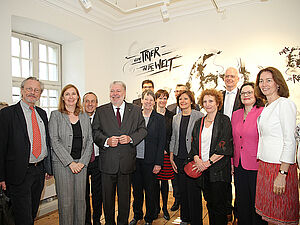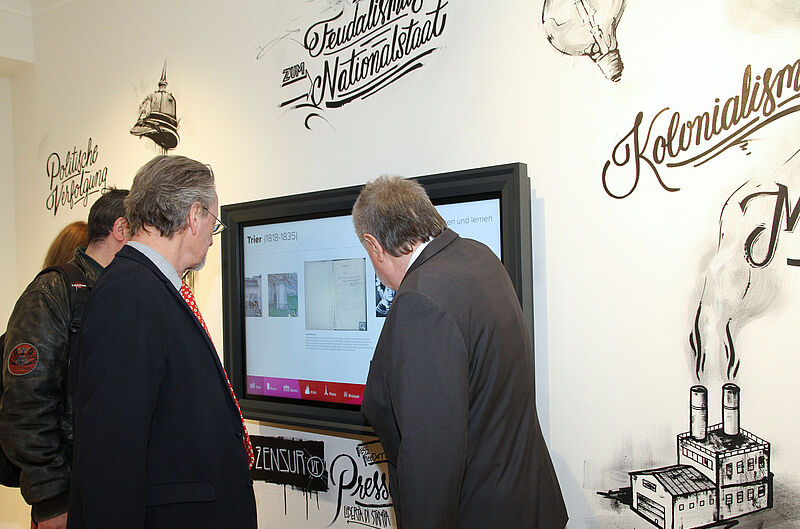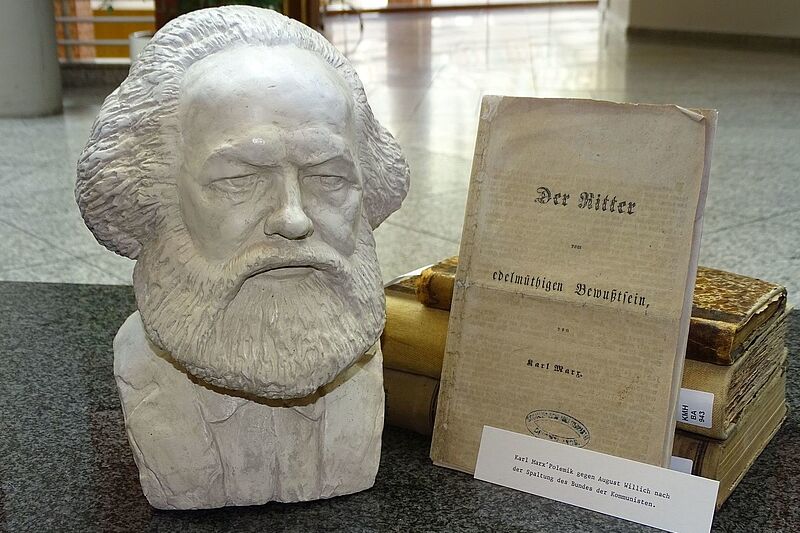Karl Marx, his ideas and their legacy down to the present
This text is published at the same time in German by FESinfo.
On 5 May 2018, on the occasion of the 200th birthday of Karl Marx, the Friedrich-Ebert-Stiftung (FES) opened a new permanent exhibition in the house in Trier where Marx was born. The show is dedicated to Karl Marx the man, the critic of 19th-century social relations and capitalism, and the impact of his ideas down to the present day from a global perspective.
The exhibition is split up into three parts.
The first part focuses on Marx's biography and his family. His life as a stateless exile and the way that this expanded his horizons are explored here. The second part of the exhibition addresses Marx's work through his most important fields of research and writing: philosophy, social science, economics and journalism.
An interactive media station presents his radical analyses of capitalist society and the critical theses with which he provoked the world in the 19th century. All this conjures up an image of an inquisitive man who was unable to complete his magnus opus, "Capital". When Marx died in 1883, only a fraction of what he had written had been published, much of it in fragmentary form, and some of it was even contradictory.
What is special about the new exhibition, however, is the third part: the impact of Marx's ideas in history down to the present day, now being presented in Marx's house of birth for the first time.
Marx lent an important impetus to the emerging workers' movement in the 19th century. He made astonishingly accurate predictions about future economic and social developments like globalization, but was unable to foresee how things would actually develop up until the 21st century.
Visitors are able to pick up a lot of interesting facts about the history of Marx's birth house thanks to a separate exhibition trail that extends through the entire house.
Marx does not leave behind any finished and complete textbook, and he is most certainly not a prophet. Following generations filled in the gaps. While some used Marx to justify violence and dictatorship on the road to communism, others—among them German Social Democrats—opted for a parliamentary-democratic path to socialist society in the first third of the 20th century. In the shadow of the Soviet Union and China, Marxist ideas became globalised after 1945, embedded in political movements and propounded by intellectuals in the West. Finally, the exhibition looks at global developments following the collapse of the Soviet Union: although Marx was held by many to no longer be relevant, he and his theses are as relevant as ever in the era of globalised capitalism.
In the wake of the 2007-2008 financial and economic crisis, Marx has experienced a renaissance. This is why the exhibition ends with a look at the present day: What kind of world do we live in and what kind of world do we seek to live in?
Marx stands out as a source of impetus and ideas in a current analysis and critique of capitalist society in the 21st century. His appraisal of society and capitalism summons and calls upon us to understand today's world and its concealed underlying structures in order to change them and free people from the shackles of exploitation.
With its sophisticated, bright exhibition design and extraordinary originals, the new permanent exhibition is very impressive, featuring among other things a first edition of "Das Kapital" in German, a hand-written letter drafted by Marx and his pocket watch.
The building itself is also special: Marx's house of birth is the largest exhibit. With a separate exhibition trail extending through the entire house, visitors are able to pick up a lot of interesting facts about its history.
The most important object is without a doubt the armchair that came from Marx's private home in London, which FES acquired for the new permanent exhibition from his descendants in 2014.
Marx spent a lot of time reading in this chair and he (very probably) died in it in 1883. The exhibition showcases the chair symbolically, as a personal moment with Marx: although he died, his ideas live on.
###
Elisabeth Neu has been working at Museum Karl-Marx-Haus for 38 years and became the head of the museum in 2014. Dr. Ann-Katrin Thomm is the curator of the new permanent exhibition at Museum Karl-Marx-Haus.
You can find out more about the Museum Karl-Marx-Haus at the dedicated website.
The new permanent exhibition is complemented by stimulating educational services offered by the museum that are especially geared to schools.
The comprehensive FES anniversary programme, which is generating a worldwide resonance, can be viewed at www.karlmarx2018.de.
The FES' cooperation partners are staging additional exhibitions in Trier to commemorate Marx's anniversary. The National Exhibition "Karl Marx 1818 - 1883. His life, work and times", is showing at the Rheinisches Landesmuseum and in Stadtmuseum Simeonstift (link in German). The exhibit at Museum am Dom addresses "LebensWert Arbeit" ("decent work"). For further information see www.karl-marx-ausstellung.de.
About FES Connect
Connecting people, in the spirit of social democracy, we source and share content in English from the German and international network of the Friedrich-Ebert-Stiftung.








